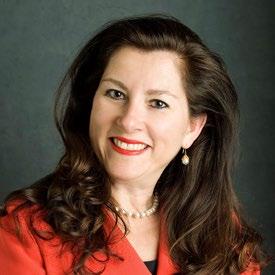
16 minute read
In the Eye of the Storm
5
IN THE EYE OF THE STORM
by Tannia Chavez, Int’l AIA
Tannia Chavez, Int’l Assoc. AIA Angela O’Byrne, FAIA, NCARB, LEED AP
Tannia Chavez, Int’l Assoc. AIA, interviewed Angela O’Byrne, FAIA, after she evacuated New Orleans in preparation for Hurricane Ida. President of an 80+ year old international design-build-develop firm Perez, APC, headquartered in New Orleans, Louisiana, with a successful branch in New York City, Angela champions the principles of smart growth in communities worldwide. The firm strives to design, build, and develop resilient communities where people thrive. This interview shares her recent experience while located within the hurricane’s eye and discusses her experience and approach to international projects.
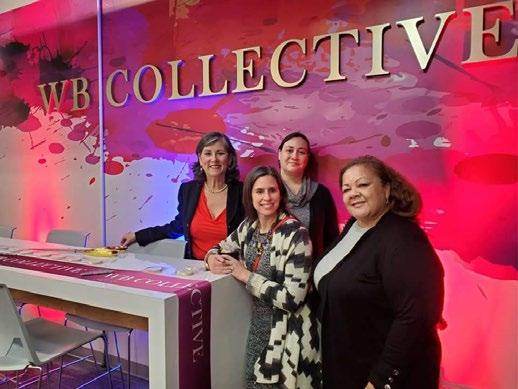
Leadership Team at Perez APC, a woman-owned firm.
GOOD MORNING, ANGELA, I AM GLAD THAT YOU ARE SAFE! HOW HAVE THE PAST 24 HOURS BEEN FOR YOU?
After learning that Hurricane Ida was one of the most destructive storms since 1850, I decided to evacuate New Orleans to better help others. Many do not have electricity and the wastewater treatment plant, sewers and gas stations will soon be down. The good news is, the hospitals are back on line as the utility company was able to provide them with power and my side yard is being used as a staging area for people to be fed and get some supplies. “It’s hard to focus on work right now, I have to refocus my priorities for a few days.”
YOUR FIRM IS AN INDUSTRY LEADER IN DISASTER RECOVERY, WAS THIS ALWAYS PART OF YOUR VISION AND MISSION?
The firm was founded in 1940 by the father of the gentleman who hired me, August Perez. I do not believe it was the founding mission, but it became a clear focus for us because Hurricane Katrina was so devastating to our city. At the time, I was President of AIA New Orleans and was up to my eyeballs in assisting people through programs, helping our members but primarily staying involved with the whole community.
DID DISASTER RESPONSE LEAD YOU TO OPEN BRANCHES AROUND THE GLOBE?
Yes. After Hurricane Katrina, I decided to open branches to be more resilient in the face of both natural and economic disasters. It gives my staff a place to work from regardless of the ups and downs in our headquarters city.
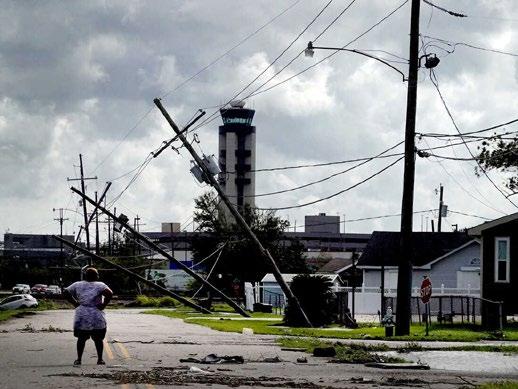
Power was lost in Mew Orleans after the electrical grid failed as a result of Hurricane Ida.” Source: NPR; Photographer: Scott Olsen
As a company, we stay focused on resiliency and sustainability, so our business model is continually evolving. Since technology has changed, so have we. Perez no longer needs so many brick-and-mortar branches. We go to where the projects are, not so much where our clients are sitting. We keep all our design models in the cloud in case we need to evacuate again, and work is done effectively from anywhere. Due to COVID-19, this has proven to be the most effective model. We can use technology to meet with our clients wherever they are and wherever we are. So now Perez offices are where we have active projects: LA, NY, OR, TX, and South Sudan. We closed our Zambia office recently after we finished that project.
YOU ARE A LICENSED ARCHITECT IN 20 STATES, A GENERAL CONTRACTOR IN THREE STATES, AND HAVE A LEED CERTIFICATION, WHAT LED YOU TO OBTAIN ALL THESE CREDENTIALS?
After Katrina, a client asked us to work on a LEED design-build project. As the contractors, we managed to get our first GC license and that’s how it all began. Since then, we’ve built 50 projects, several designed by our firm. My Masters Degree in Real Estate Development also helped with the design-build approach for Federal Government projects in various states including New York and New Jersey; the LEED certification was a natural progression.
YOU ARE A PASSIONATE ADVOCATE FOR WOMEN IN ARCHITECTURE AND CONSTRUCTION, WHEN DID IT START?
My company worked in Afghanistan from 2007 to 2017. We did many projects there, in some cases as the prime design-builder, in others the subcontractor to a prime called Technologists Inc. Then I witnessed women’s oppression - luckily not for everyone! There are many families in favor of their women being educated. A big part of the American mission was to make education available to young girls and women. We worked on a high school project in which the principal mentioned that the girls were at risk of coming to the school and could get murdered, even for wearing a school uniform. Later, we worked on a dormitory at the American University of Afghanistan for 200 women, so they did not need to commute, and it would be safer to study. I have read that 70 % of the population was born after the war started with America. The young population always had some choice, the ability to go to school, and social media. It will be hard to control the country, especially the women, the way they did before - I only hope the best for them. I believe because of Perez being a woman-owned firm, we attract a lot of women - but of course, we have great guys too! There is a good mix of staff right now; the leadership in the company is primarily women, but it has more to do with the employees. Our company’s culture is gender blind and color blind; we only hire the best people for the job.
HOW DO YOU FEEL WHEN HURRICANE SEASON IS APPROACHING?
There is always some trepidation surrounding what might occur each hurricane season. Every time a tropical storm or hurricane hits our city, we learn valuable lessons about how to handle it better the next time. Every storm causes a new and different type of damage. This time, the levees held with no massive flooding, but the electrical grid was destroyed. Eight high transmission towers failed, causing over 900,000 people to be left without electricity. For future protection, the infrastructure must be installed underground, even if it’s an expensive measure. It’s fundamental to design and build for these circumstances, especially when we know they are coming (and seemingly more often). Nowadays, the Building Codes are much more strict, which helps to build safer communities.
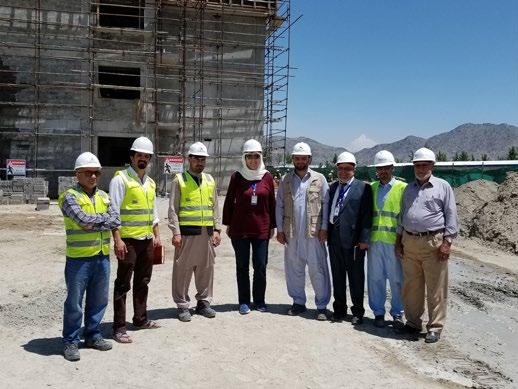
One of Perez’ teams in the Middle East.
WHAT IS YOUR LESSON LEARNED FROM ALL THE PREVIOUS HURRICANES AND NATURAL DISASTERS?
I learned to be prepared to evacuate! Being safe enables me to support my family, friends, and all those that must stay.
continued on page 24
My design practice emphasizes that rebuilding affected areas must prioritize hurricane resistance. For several years, we have been raising the utilities, equipment, and first floors above the base flood elevation. All these lessons were learned from New York City after Hurricane Sandy. It’s crucial to build a more sustainable future and more resilient cities.
HOW HAS YOUR TRAVEL AND WORK ABROAD INFORMED YOUR DESIGN PROCESS? IS EVERY PROJECT SOLVED DIFFERENTLY? DO YOU HAVE ANY UNIVERSAL PRINCIPLES FOR DESIGN?
When working overseas, we try to maintain the same standards that we have here in the US., which tend to be higher than in the countries we commonly build. Many regulations adopted by our building codes are not possible to follow in foreign countries. For example, if the client cannot operate and maintain a fire-sprinkler system, our approach is to install an older version - we have used fire hoses in some cases. Most countries do not have a fire department responding to disasters, making it pointless to install an alarm system. It’s challenging, and we must find ways to adapt! It’s indispensable to get them to the most resilient point, always considering the local skill sets available for operation and maintenance. ability. The systems in the building are more exposed. For example, you can see what’s happening with the mechanical, electrical, plumbing, and fire protection systems. Some walls have plaques explaining the building’s systems. The academy’s building process explanation became part of their science curriculum.
WHAT DOES SUCCESS AS AN ARCHITECT MEAN TO YOU AND WHAT DO YOU THINK ABOUT YOUR LEGACY?
These are big questions! Success for me is to design projects that serve our clients but primarily the end-users of these buildings. A broad audience needs to thrive in the newly developed communities. It means being financially capable of taking care of our employees, ensuring that they are getting a living wage to enjoy life and take care of their families. Often, we do public work in very disinvested neighborhoods, which most likely are in environmentally challenging locations. I like to think about what we can do to socially impact a community, acting as catalysts to help them develop and improve over time. For example, the Neonatal Intensive Care Unit located in Zambia was intended to reduce the infant mortality rate, which is very high in the region. It was very moving to see how committed the Zambians were to the University Teaching Hospital. The staff is one neonatal practitioner for the entire country (fortunate to be trained in South Africa), one biomedical engineer trained in China, and maybe ten nurses. The Zambian philosophy is to serve their country, even with very few resources. They truly work under-resourced, but nothing stops them! My legacy would be that exact definition of success: built projects that have a lasting impact on their communities and leave them better than how we found them. That’s my goal, and I know it’s the goal of everyone that works at Perez!
HOW DO YOU STAY COMMITTED TO EVERYTHING YOU DO AND STILL HAVE A WORK-LIFE BALANCE?
I love what I do! It’s easy when it doesn’t feel like work! And being paid to do what you love is a true privilege. Secondly, I come from a Latin family (very close-knit), so it comes naturally to take care of each other. During the past year, I started spending more time with my family, eating healthier, meditating more, doing yoga, and hiking. I am now preparing to hike the Camino de Santiago de Compostela. Since my city is temporarily down with no power, I might do it now!
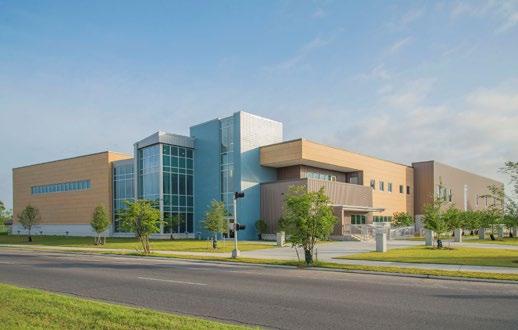
Andrew P. Sanchez & Copelin-Byrd Multi-Service Center, New Orleans, LA
CAN YOU SHARE A PARTICULAR PROJECT THAT IS ESPECIALLY CLOSE TO YOUR HEART, KNOWING THAT SUSTAINABILITY AND RESILIENCE WERE ACCOMPLISHED?
Wow, that’s a difficult question! It’s like which is your favorite child? One of my favorite projects is the Andrew P. Sanchez & Copelin-Byrd Multi-Service Center in New Orleans, Louisiana. That area did not have a community center for ten years after Hurricane Katrina. President Obama came to the building to give a speech on the 10th anniversary of the hurricane when it opened. From the design perspective, it’s a beautiful building, and serves its community well. Another is the Patrick F. Taylor Science & Technology Academy, also located in New Orleans. It’s LEED Silver accredited and built in a way that teaches the students about sustain-
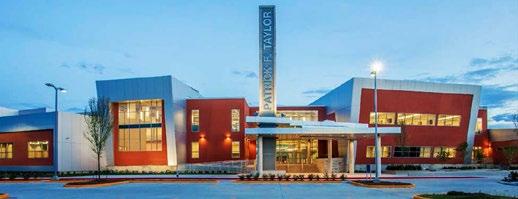
Patrick F. Taylor Science & Technology Academy, Avondale, LA

Over the past year, Angela started to hike for more work-life balance. She is currently preparing to hike El Camino de Santiago de Compostela. The Camino de Santiago, known in English as the Way of St. James, is a network of pilgrims’ ways or pilgrimages leading to the shrine of the apostle Saint James the Great in the cathedral of Santiago de Compostela in Galicia in northwestern Spain, where tradition holds that the remains of the saint are buried.
There is only so much that you can control, so I try to keep it all in perspective by laughing a lot and watching good comedies.
WHAT STEPS CAN THE EMERGING PROFESSIONALS TAKE TODAY TO CREATE A MORE SUSTAINABLE AND RESILIENT FUTURE?
Technology keeps changing everything - technology is the key! Learn what’s coming next and stay on top of your game. Learn how to use big data, 3D, and 4D printing in your design process. I think it’ll help new projects to stay on budget, making it easier for designs to be more resilient and reduce the effects of climate change. As the younger generation, this responsibility is now in your hands! l


Westbeth Artists’ Housing | Located at a Hudson River-front location, the historic Bell Telephone Laboratories building at 55 Bethune Street in the Far West Village was converted to affordable live/work housing for artists nearly 50 years ago. https://westbeth.org/wordpress/about/history/
A team member from the Perez office in New York states: “I've spoken with the General Manager and GC at Westbeth Artists' Housing. There were no damage pictures taken during Hurricane Ida at Westbeth. The event happened after the crews had left for the day. When they returned in the morning, everything was dry, and there was nothing to report. All of the Build it Back flood resiliency implementations performed as intended. Most of the implementations are not visible because Westbeth is a national and NYC landmark. The window fenestrations at ground level have received interior mounted flood panels as those locations were where Sandy waters first penetrated the building and proceeded to flood 70,000 square feet of the basement. The design intent was to relocate most of the equipment above the 12' Design Flood Elevation and make watertight what could not be relocated. There are two interior flood doors to protect Fire Sprinkler equipment in the basement that could not be relocated.”
Tannia Chavez, Int’l Assoc. AIA, is a Licensed Architect in her home country, Ecuador. She is a Project Manager at OMFPE Consulting in New York City. Tannia founded AIA Brooklyn’s Women in Architecture Committee in 2019 and is currently serving as New York Regional Associate Director to the AIA National Associates Committee.
President of an 80+ year old international design-build-develop firm Perez, APC headquartered in New Orleans, Louisiana, with a successful branch in New York City that has just celebrated its 15 year anniversary. Angela O’Byrne champions the principles of smart growth in communities worldwide. The firm strives to design, build, and develop resilient communities where people thrive. Born in Cali, Colombia, Angela earned a Master of Architecture from Tulane University and Master of Science in Real Estate Development from Columbia University. She has since become a licensed architect in twenty states, a licensed general contractor in three states, a Fellow of the American Institute of Architects, and a LEED Accredited Professional. Her 40 years of experience in design and management of diverse project types includes multi-unit housing, hospitality, recreation, master planning, historic renovations, education, government buildings, LEED certified projects, military construction, and more. Angela is also a passionate advocate for women in architecture, construction, and development, and is involved in numerous professional and nonprofit organizations dedicated to their advancement in the industry.
We deliver your project to you!

Our team of skilled technicians leverage leading technology to precisely capture data to help workflow efficiency resulting in greater profitability for your business.

Construction Progress Documentation
360° Photo & Video • Photogrammetry • VR Tours
Construction Documentation Services
Wide Format Printing • Public Bid Hosting • Signage
High Accuracy 3D Building Surveying
Existing Conditions • Point-In-Time • Final As-Built
Deliverables Include:
• 3D Revit models • 2D CAD Drawings • 360 Photo & Video • Raw 3D Point Cloud • Dimensional photos • Data Management
Schedule a demo today!
www.printeks.us.com support@printeks.us.com 25 Wallkill Avenue Montgomery, New York 12549 (845) 294-0877

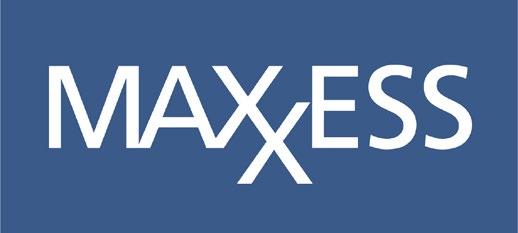
CRITICAL ELEMENTS OF ENTERPRISE RESILIENCE
A hallmark of a resilient enterprise in today’s complex, hybrid work environment is its ability to respond to critical events in a timely and effective manner. The policies and procedures define the enterprise’s many functions that must be part of its response. Since it is not practical to accurately define a critical event, these policies and procedures must focus on the highest priority functions of the enterprise with as few assumptions as possible regarding the security systems and infrastructure that will be available to it. For many enterprises, it’s a challenge to ensure that its local systems and infrastructure can be resilient in the presence of critical events without significant investments in redundant, non-collocated resources that may be expensive for many enterprises. Enterprises are becoming more dependent on shared systems and infrastructure to provide even critical functions. This has the obvious disadvantage that the enterprise itself can’t directly enhance the resilience of shared infrastructure. However, most of these shared resources are already more resilient than it is economically possible for most enterprises to implement on a local basis. Additionally, major shared infrastructure resources [e.g., power, Internet service providers, and cloud service providers] offer the ability to provide enhanced resilience at incremental service costs. When the infrastructure and policy are properly implemented, it’s the people present that can enable an enterprise to meet its obligations in the presence of critical events. Since people represent an extremely significant component of the resources that any enterprise requires to function, efforts to enhance the resilience of the enterprise’s people must represent a significant aspect of its efforts to improve its organizational resilience. For example, the 7th largest school district in California has 60 schools with approximately 50,000 students and over 4500 employees. They need a powerful security and operations solution that was able to increase situational awareness and minimize response time. Their Emergency Operations Center (EOC) needs to be informed of missing people, dangerous situations, property damage, and more. They chose Maxxess InSite to provide private, two-way, managed messaging and intel on a more personal and intuitive level. The solution leverages the power of smart mobile devices to maintain comprehensive communications and emergency management operations provide a trusted messaging system between an enterprise and its people that can provide controlled, confident connections that can enable the people not only to respond to the enterprise’s needs, but the enterprise to respond to the people’s needs as well. Their main uses for the system were response coordination to broadcast mass notifications to quickly monitor staff status, communicate with staff members in an organized manner, and help first responders communicate effectively. The other aspect they needed was situational awareness. The InSite system allows emergency messages to transmit GPS location to activate the closest camera view for responders. The school district was also given the opportunity to train staff using InSite’s simulation tools to create training scenarios. They were able to create procedures, implement infrastructure, and then train the necessary people to create a resilient enterprise.







